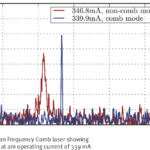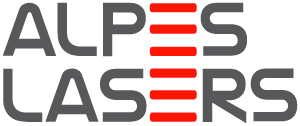Room Temperature Continuous Wave Frequency Comb Laser
RT-CW-FC-QCL
Frequency Comb Quantum Cascade Lasers are devices emitting light on a wide spectrum consisting of equidistant peaks in frequency space. The distance between these peaks being fixed, typically given by the pulse repetition rate of a train of ultrashort pulses, they can be used as rulers in the frequency domain for Frequency Comb Spectroscopy.
In the mid-infrared range, Quantum Cascade Lasers with specifically engineered optical dispersion have been shown to emit broad and powerful optical frequency combs. As for ultrashort-pulse lasers, the mode spacing of QCL combs is given by cavity length. However, in the case of QCLs, the periodic modulation in the time-domain is of the FM, not AM, type and the output power is constant.
The wide and flat gain spectrum of Broad Gain Lasers make them suitable for operation as Frequency Combs. As the operating range where comb operation can occur is very sensitive to the fine structure of the heterostructure, each QCL-Comb is tested and qualified.
The QCL comb is a stand alone device as it integrates the pump laser and the microcavity in its waveguide contrarily to other comb technologies. This makes it a very compact comb source. Being based on QCL technology, comb devices can be manufactured over all the MWIR and LWIR. Frequency Combs with the following specifications are currently available with a 8 weeks lead time; inquire for other wavelength ranges.

While a similar technique has also been demonstrated using standard Fabry-Perot QCLs, the much narrower intermode beat linewidth of QCLs operating in the comb regime allows to stack a much larger number of beat notes within the RF bandwidth of the optical detector, resulting in higher resolution and/or broader spectral bandwidth.
Ultimately, the spectral resolution (i.e. finesse) as well as the carrier offset stability are affected by the drivers used with the frequency comb and not by the chip.
QCL-based dual-comb spectroscopy offers the possibility to acquire high-resolution spectra over a wide spectral range of several tens of cm-1 in a very short acquisition time of the order of µs, i.e. in quasi real time. This technique combines the advantages of DFB -QCLs, i.e. narrrow linewidth and mode-hop-free tuning,with the large wavelength coverage of external cavity QCLs.
A sample datasheet of a Frequency Comb Laser with emission centered around 6.02 μm can be seen here.
See related products:
Tagged CombCWMulti-ModeQCL

